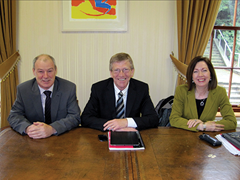Armagh, Banbridge and Craigavon: history and overview
 agendaNi summarises the heritage and economic opportunities of the North Armagh and West Down areas.
agendaNi summarises the heritage and economic opportunities of the North Armagh and West Down areas.
The new Armagh, Banbridge and Craigavon council will cross traditional county boundaries but is otherwise a natural fit for three areas with much in common.
Armagh, the most rural of the present districts, has long laid claim to city status. Its name (Ard Macha in Irish) refers to the Celtic princess Macha and Emain Macha (Navan Fort), the royal capital of Iron Age Ulster. St Patrick established a church on the site in 445AD and it has since remained the seat of Catholic and Church of Ireland archbishops. The Royal School, Armagh Observatory and Georgian architecture grew up around the Anglican cathedral. Construction on the more recent Catholic cathedral began on St Patrick’s Day 1840 and it was consecrated in 1904.
The Upper Bann valley flourished in the Industrial Revolution as linen mills provided jobs for local people and railway lines crossed the landscape. The towns of Portadown, Lurgan and Banbridge grew and prospered.
With the demise of linen in the 1960s, Craigavon presented a fresh economic opportunity: a new town (potentially a city) modelled on the success of Milton Keynes. Industries and public services were centralised in this hub, which became known for its cycle-paths and roundabouts, but population growth did not match the optimistic estimates and the Troubles stalled development.
Craigavon and Banbridge’s towns and villages increasingly became commuter settlements for Belfast, but the growth of local companies such as Almac has boosted their economy over the time of the peace process. Increasing numbers of tourists also discovered the area’s rich natural and historical heritage, from the foothills of the Mournes to Oxford Island at Lough Neagh and the culture attractions of Armagh. The award of city status to Armagh in 1995 formally recognised a contribution that it makes to Northern Ireland and the island as a whole, and it has subsequently become home to the headquarters of the North/South Ministerial Council.
When the Northern Ireland Regional Development Strategy was being prepared, people in the proposed district identified the availability of land for building, the area’s travel corridors and its green spaces as some of its strengths. However, local people also recognised the need to “think in terms of the bigger picture, not locally” in order to give the area a competitive edge. The proposed re-opening of the Ulster Canal, leading to the Erne and Shannon waterways, is one example of an outward-thinking approach.
Pharmaceuticals and food provided an industrial niche with Craigavon being Northern Ireland’s second largest manufacturing base. Retaining farming skills and developing tourism skills were viewed as two priorities. The Dickson Plan has resulted in above average results for Craigavon’s schools and Banbridge and Armagh also have good reputations. However, local people felt that the “educational basics” needed to be tackled at primary school level.
The area has a large number of small towns and the Regional Development Strategy consultation showed that residents wanted them to work together and see where they can add value to the local economy e.g. clusters of businesses or marketing them together as tourist attractions.
2015 therefore marks a new chapter in the district’s rich history with the merger of the three councils offering the potential for people across the area to work together more closely to make the most of its potential.





